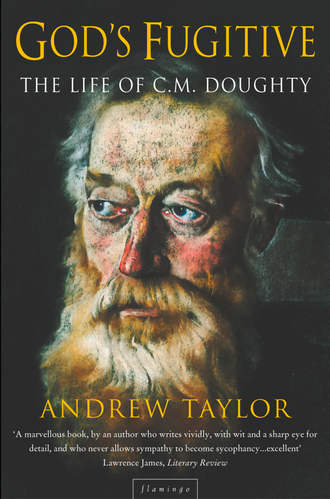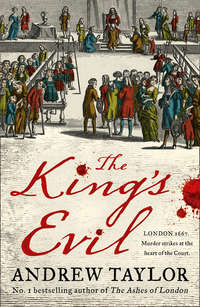
Полная версия
God’s Fugitive
Most of his notes from Sinai deal with the geology and the structure of the region: to an even greater extent than elsewhere on his travels, this was a land where history could be read in the rocks and stones, and picked up from the occasional ruins of human habitation. But that history was clear, the links between past and present undisguised. Within this bare, forgotten and cruel land could be found not only the ancient soul of Arabia, but also the first clues to the origins of human civilization.
In the spring of 1875 Doughty left Sinai, apparently without much regret, making his way north through the complex system of wadis and granite cliffs towards Aqaba and on through the biblical land of Edom to Damascus. With him were an Egyptian and a bedu guide, fellow-travellers on a journey where every encounter with the tribesmen could mean either mortal danger, or the warmest of welcomes.
The town of Maan,28 which was their first destination, lay at the edge of a desolate plain, covered with flints and stones, with no shelter from the wind or the beating sun. Here, in a dip in the ground, they waited nervously until nightfall before setting out across the open country to the town. His two companions, more alive to the dangers of the route than Doughty was, warned that any passing group of nomads might now be a threat: their only safety lay in hiding until dusk. It was midnight before they arrived at the town. ‘The place lay all silent in the night. We rode in at the ruinous open gateway and passed the inner gate, likewise open, to the suk: there we found benches of clay and spread our carpets upon them, to lodge in the street.’29 Doughty’s plan now was to travel on to Petra, the Nabataean city which had been made famous by the young Swiss explorer Johann Ludwig Burckhardt30 more than sixty years before. This, surely, would be the climax of his painstaking studies of ruined settlements and inscriptions. ‘I had then no other intention than to see Petra. I could speak very little Arabic, not having before studied the history of those countries,’ he wrote later.31
The ancient rock city was only five hours’ ride away, and he set off eagerly, past another ruined site, long stripped of its white marble pavements by the rich traders of Damascus, and on through the outlying cornfields of Maan – fields where the desert met the sown, in Gertrude Bell’s later phrase, and where the farmers had no choice but to offer half their crops to the bedu as a bribe for an untroubled life.
How would the local Arabs react to the arrival of this mysterious red-bearded European, riding a mule and wearing an Ottoman-style red tarboosh, who demanded to see the ancient sites that they still treated with a degree of near-religious respect? At first the tribesmen at the village of Eljy demanded money to let him through to the ruins; then he was treated with suspicion as a possible spy, and finally entertained to a meal of mutton boiled in buttermilk. The meal, as Doughty was to discover later, was significant: once he had been entertained to food and drink by the tribesmen, once he had shared their ‘bread and salt’, he was protected by the laws of hospitality.
The track down to the monuments, he noted with an English country gentleman’s fine sense of bathos, ran though ‘limestone downs and coombs … like the country about Bath’; but from there, among the red sandstone cliffs, he could make out the palatial columns and cornices of the Nabataean city. Burckhardt must have been faced with the same intriguing panorama when he scrambled over the track years before.
At closer quarters it was a world of contradictions: grandiose two-storey facades which fronted nothing but plain, uncarved caves, hacked out of the rock face; a town where the houses had vanished and only the empty tombs in the rock remained.
It was initially courage, resourcefulness and good luck that had brought Burckhardt there; then learning and intelligence that made him realize that the ruins were indeed those of the fabled city of Petra. He had been alerted to their existence in the Wadi Mousa by the casual talk of local people, as he travelled south towards Maan and, disguised as a Muslim traveller from India, he had decided to risk his life by trying to see them for himself. It was much the same decision as Doughty would have taken – except that Burckhardt had his disguise and a story he had concocted about a vow to sacrifice a goat at the nearby Tomb of Aaron to explain his presence. Doughty made no pretences: he simply told the curious, occasionally hostile villagers that he wanted to see the ruins.
Perhaps it was the red tarboosh that persuaded the Arabs to let him through: despite its crumbling power, the Ottoman empire still wielded considerable influence in the region, and the hat may have reinforced Doughty’s own claim to have powerful friends. However vehemently the villagers protested their independence, they would have been unwilling to try to outface the authority of the Dowla, the Ottoman government. But, after a night spent in caves in the rocky face on the outskirts of Petra, there were still other locals to stand in the way: one group of four with a gun grabbed the bridle of Doughty’s mule, and refused to let him through unless they were given money; another goatherd, looking after his flocks with his wife, warned him to keep off the mountain slopes, for fear of attack. Fifty armed men, the Arab warned, would not be enough to protect him against the angry villagers if he tried to climb out of the valley.
In the valley-bottom, though, they found the long, deep cleft through the rocks known as the Siq, a natural passage-way through groves of wild olives to the carvings – and at the end of it, the Khasneh, the so-called Treasure House of the Pharaoh, the most perfect of the monuments. It was no disappointment: its ‘sculptured columns and cornices are pure lines of a crystalline beauty without blemish, whereupon the golden sun looks from above, and Nature has painted that sand-rock ruddy with iron-rust’.32
Ignoring the villagers’ warnings, they climbed out of the valley to the cold mountainside, and found a place to stay for the night in a bedu encampment, where they were entertained with music and singing (enough, said Doughty ungratefully, to ‘move our yawning or laughter’) before spending another day at the monuments. Leaving his mule at the Treasure House, Doughty set off with another local guide to explore the carvings and inscriptions until, as the sun set, the anxious young Arab urged him to leave. It was not clear whether he was more afraid of the marauding bedu or of the angry spirits of Petra. His plan was to spend the night back at his own village, where Doughty had been entertained three nights before – but when the villagers there heard the sound of the mule’s hoofs on the rocky track, they poured out of their houses to drive them away. No unbeliever should enter the place, they shouted – and the man who had tried to bring him was reviled as ‘Abu Nasrany’, father of Christians. They were forced back up into the hills, back to the bedu encampment they had left earlier.
Doughty did not seem to care what happened to his guide. For him, the attack by the villagers was little more than an exciting interlude, an introduction to the unpredictable hostility of the tribesmen. But the visit to Petra had given a fresh dimension to his travels. While the mosquito huts of Sinai spoke of a primitive people struggling to survive, these grandiose carvings – reduced now to ‘night-stalls of the nomads’ flocks and blackened with the herdsmen’s fires’33 – were the remnants of a long-vanished prosperous race of builders, traders and merchants. It was there, in the shadows of ‘that wild abysmal place which is desolate Petra’,34 that Doughty’s dreams of discovering another civilization were born.
During the long nights on the mountainside above Petra the villagers had let slip details of just such another civilization. There were, they said, similar sites further south down the Hadj road, on the way to Mecca. It was the first mention Doughty had heard of a second Petra – and it had come to him in much the same casual way as had Burckhardt’s initial information about the first one. At first the villagers were unwilling to talk about the sites, particularly to a curious European Christian, but they assumed that Doughty had arrived from the south, and must already know about them.
There were several separate sites, known as Medain Salih – the cities of Salih, a Muslim prophet, who was said to have destroyed them and their inhabitants because of their wickedness. Each one was hewn from the solid rock like Petra. Doughty’s immediate thought was that he might be the first European to document those remains.
And in Maan there was more to be learned: a secretary named Mahmud – ‘a literate person who had been there oftentimes’ – told him about the inscriptions and the carved birds on the massive stone facades. ‘With those words, Mahmud was the father of my painful travels in Arabia,’ he noted later.35
The cities were well within the reach of a determined traveller – some ten days’ travel, according to the people whom Doughty asked. He wanted to set off south at once to see whether the stories he had heard were accurate – attracted, initially at least, by the possibility that the ruined cities might be connected with the stories of the Old Testament. ‘I mused at that time it would be some wonder of Moses’ Beduish nation [of] Midian,’ he wrote some years later. ‘For those inscriptions which might yield fruit to our Biblical studies, I thought it not too much to adventure my life.’36
Other stories of the Arabian hinterland that may well have been intended to warn him off simply increased his fascination – stories of a cruel and powerful prince, who ruled over his desert kingdom as both tyrant and lawgiver. ‘All the next land of wilderness was ruled by one Ibn Rashid, a mighty prince of Beduin blood, who lorded it over the tribes … I thought I had as lief see his Beduin court, and visit some new David or Robin Hood, as come threading these months past all the horrid mountain mass of Sinai,’ he said later.37 Here, surely, there would be more to fire his imagination than he had found in Europe.
But his first attempts to join the pilgrimage that might start his journey there were rebuffed: the Ottoman governor of Maan, well aware that he might be held responsible if anything were to happen to this headstrong European in the harsh country of the desert bedu, forbade townsmen and travellers alike to help him find a way down the Pilgrim Road.
The only way of reaching Medain Salih, the governor said, would be to accompany the Hadj caravan from Damascus – a suggestion which was clearly a way of fobbing off this importunate Christian.
The governor’s caution was understandable: from his point of view, it was the worst possible time to have a European Christian who claimed the highest political connections setting out on such a dangerous and unpredictable venture. Within the past few months tension had been growing throughout the Ottomans’ Balkan possessions, and both the Russian Tsar and the western powers were making threatening noises about the need to protect the Sultan’s non-Muslim subjects from the excesses of their masters.
In Constantinople Sultan Abdul Aziz was clinging to power by anxiously playing off Russians against Europeans. Allowing Doughty to wander through the wilder corners of the empire would risk demonstrating how feeble was the Sultan’s grasp on the extremities of his dominions – and if he were to come to harm, it might provoke an anti-Ottoman cause célèbre in the West. Any provincial governor who caused such a diplomatic disaster merely to oblige an eccentric traveller with a penchant for ancient inscriptions would surely attract the unwelcome attentions of the Sultan’s stranglers.
So Doughty spent twenty frustrating days in Maan, becoming well known in the streets and coffee houses, as he tried to glean more information about the monuments of Medain Salih. He also took to wandering through the flint beds just outside the tumbledown clay wall around the town, where he found traces of still earlier inhabitants than those of Petra. Lying near the surface, to his astonishment, were seven flint tools, chipped to a sharp edge. It was a tribute to Doughty’s own powers of observation, sharpened at the archaeological site of Hoxne all those years before, that he recognized them. They were another imaginative link with people from centuries before. ‘We must suppose them of rational, that is an human labour. But what was that old human kindred which inhabited the land so long before the Semitic race?’38
They were, indeed, from long before the Semitic race, some of them dating back to Lower Palaeolithic times, hundreds of thousands of years before the appearance of modern man. Forty years later Doughty presented the axes, amongst other trophies, to Oxford University’s Ashmolean Museum – and along with them, incidentally, his own clumsy effort to copy the craftsmen of prehistory.
Today they shine dully in shades of green, brown, and grey, still fitting snugly into the palm of the hand, still sharp along the chipped edges, but each one now carrying a precise little note, in Doughty’s schoolmasterly hand, to say where it was found.
‘They were certainly a significant find – they wouldn’t have seen many pieces like this in Britain in 1915,’ says Alison Roberts, the collections manager in the museum’s Department of Antiquities. ‘Not much was known about the Palaeolithic era in Syria or the Near East at that time, and most European archaeologists would have been as excited as Doughty himself to see them. The writing on them is interesting too – it shows Doughty was a very careful, conscientious collector. A lot of people weren’t, in those days.’
When he found them, though, Doughty’s attention was fixed on Medain Salih. Everything he heard simply whetted his appetite more keenly: the cities lay close together near the pilgrim trail, about halfway between Maan and Medina, their rock chambers like those he had already seen at Petra, but bigger – and every doorway had an inscription and the figure of a falcon or an eagle, wings outspread, carved over it. However close the links with Petra, he believed there was every chance that he might find the remains of a previously unknown desert civilization.
He used all his powers of persuasion with the governor. Although the journey would be difficult and dangerous, he argued, it would not take him into the area of the two Holy Cities which were forbidden to non-Muslims on pain of death. But it was useless: the governor had clearly decided not to take the responsibility of allowing him to make the journey. He would have to travel north to Damascus and try to find more powerful backing.
So, after failing to get permission in Maan, he set off for Damascus. Eager as he was, he does not seem to have hurried on his journey.39 He spent several months wandering through the countryside, adding to his collection of inscriptions and stories of the region’s biblical past. It was hard travelling, often with nothing more than a night under the stars in the shelter of a few rocks at the end of the day – but it took Doughty deep into the history of the ancient land. He found a chain of old watch-towers and fortresses stretching a hundred miles or so into the desert, each one with its own story – one was ‘a kasr of the old Yehud’, a castle of the ancient Jews; another was reported to be a palace, and a third, scattered with broken columns, and with a massive marble stairway leading from the deserted entrance hall, now no more than the den of some wild beast.
There were silent piles of stones still standing where they had been painstakingly gathered in long-abandoned fields; entire towns and villages, ruined and deserted, which seemed to date back hundreds of years.
The ruins … are built without mortar, with the uncanny natural blocks of flintstone and limestone. There are even, in several of the remains of the regular buildings, foundation walls, vaults, and round arches made of square carved stones which on appearance might have been made by Roman hands – column pieces, marble fragments, etc …40
The villages that were still inhabited bore a striking resemblance to the ruins in their design and construction: in the past, Doughty’s guides told him, this had been a thriving farming region, which had been laid waste years before by a bedu sheikh. Myth, history, or a combination of the two, the awestruck stories told by the Arab farmers bore witness to the dread they still felt of the half-savage nomadic tribes who could descend upon them so suddenly and so brutally. Fear, too, could survive almost unchanged down the generations.
Sometimes, Doughty paid an Arab guide to accompany him on his way; where he had to, he travelled alone, trusting to his luck and his ability to talk his way out of trouble. But whenever possible he fell in with other travellers going on the same track: there were stories to be heard along the way, and some safety to be found in numbers. As he left Maan, for instance, he joined the military captain of the Hadj road and twenty or so of his peasant soldiers, on their way to Nablus. They were well enough armed to frighten off any casual groups of bedu tribesmen they might meet – but he still had to rely on his own wits rather than on the loyalty of his companions. On one occasion, threatened by a group of nomads, he resorted to a straightforward bluff, and shouted orders to the men to arrest them, as if he were a military commander. The soldiers, of course, who had anyway not been paid for nearly a year and a half, were even less likely to obey him than their own captain – but the Arabs didn’t know that, and they rode off in panic from the scruffy little troop and their guns.
It was now June, and the countryside was blooming. Doughty had reflected as he left Maan on how the land must indeed have seemed to flow with milk to the Israelites as they trekked wearily out of the wastes of Sinai. Now he found rose-laurel and rushes growing in profusion around the cattle pools, swollen with the spring rain; the grass was a yard high, and the corn growing fat. The bedu he met were turning their cattle loose on some of the richest pasture of the year, and, unpredictable as ever, they were happy to slaughter a sheep for dinner in honour of their guest.
He paused briefly in the town of Kerak, a rough settlement with a bloody history of wars and conquests, which had the air of a frontier town, where criminals and murderers could seek refuge from the stern justice of the Ottoman empire. The countryside round about was dotted with ruined forts, towers and villages, but he did not linger. It was still June when he was a good hundred miles further north, wading up to his waist in the tepid waters of Wadi Zerka, as they tumbled towards the river Jordan.
The biblical land of Gilead, through which he passed on the way to Jerash and Damascus, sounds like a paradise, ‘full of the balm-smelling pines, and the tree laurel sounding with the sobbing sweetness and the amorous wings of doves! In all paths are blissful fountains; the valley heads flow down healing to the eyes with veins of purest water’.41 For all that, though, it remained outside the law. The people, ‘uncivil and brutish, not subject to any government’, slashed and burned the woodland as if they were living in some remote rainforest: it was a grim and primitive land.
All the time, he was becoming more familiar with the Arab way St Mary’s Church, Martlesham, Suffolk: ‘The atmosphere of the simple little church, its unimpeachable, unassuming Englishness and its dignified reserve, reflect one facet of his character.’ of life and culture, even though he had yet to learn more than a smattering of the language. The wild bedu, still largely unknown and untrusted, seemed to people an uncivilized world in which they made their own law, while on the desert fringes the hard-working farmers and traders eked out a living that seemed to have been unchanged for centuries. ‘These desert men lean to the civil life, and are such yeomen perhaps as Esau was. Other of their tribesmen I have seen, which are settled in tents, earing* the desert sand near Gaza; their plough is a sharpened stake, shod with iron, and one plough-camel draught …’42
But these industrious farmers, too, could turn on him in a moment. They distrusted foreigners and particularly those who, prying into ancient ruins, might prove to be spies. A European and a Christian in a strange land, either alone or with few companions, he was an easy target either for religious bigotry or simple banditry by farmers and nomads alike – the more so when he steadfastly refused to adopt a disguise or make up stories to justify his presence.
There had been his brush with the villagers around Petra; and there had been another incident south of Wadi Zerka when Doughty, sick and weak with his long travelling, was abandoned by his guide at a bedu encampment. At first he was well enough treated: the Arabs made at least a pretence of trying to find the guide who had deserted him, and gave him food and shelter. But they were moving on, they said, and after one night they delivered him to a second encampment.
There, Doughty found only women – and when the men returned later in the day, it was to threaten him, and demand a ransom in return for letting him go. It was a gross abuse of the laws of hospitality – but Doughty was becoming more skilled in the ways of handling the nomad tribesmen. First he protested that he had been given milk to drink by the women of the tribe, and should therefore be treated as a guest; and when that failed, he suggested that the leader of the group, Sheikh Faiz, should give him his horse in return for the ransom – one gift for another.
When Faiz’s mare was brought forward, though, he looked at it in disgust, and told the sheikh it was not even good enough to accept as a present. Faiz, presumably, was not particularly popular among the tribesmen; at any rate, they took Doughty’s side, and laughed at their leader’s discomfiture. Winning support with a pointed joke and a pained expression remained one of his favourite survival techniques.
He arrived in Damascus weary and sore. His six months in the deserts, the mountains and the wadis had been a completely different experience from anything that had gone before. Physically, it had been an exhausting and draining ordeal, struggling by camel and mule over some of the most inhospitable country in the world – but, more than that, he had been more alone, more exposed, than at any time in his life.
As well as his excitement at the prospect of finding the ruins of Medain Salih, he was finding aspects of daily life and culture among the Arabs that inspired his deep and lasting respect; but, for all his occasional sense of kinship with travellers who had gone before him, it was knowledge won against a background of remoteness and fear. In Europe, after all, he had been surrounded on his travels by the comforts and reassurances of a familiar way of life: even when he slept under the stars, it was within reach of people who shared his standards and values, people with whom he might enjoy a mutual understanding. When he trekked out into the desert of North Africa, it had been a brief excursion into a foreign land – and an excursion made still under a recognizable framework of European colonial law and authority.
Doughty may have lived as a poor traveller before, but it had been in a sympathetic world. His poverty, too, had been at least partly assumed – there had been times, as in Lisbon, where he could briefly drop back into the comfortable lifestyle of an Englishman of a certain class.
Here in the Bible lands he was isolated under the arbitrary and uncertain law of a cruel and largely hostile country, and travelling always on the fringes of what appeared to be a wasteland of lawless savagery. The familiarity which his biblical knowledge might have brought to the terrain often served simply to emphasize the gulf between the magnificence of the past and the squalid meanness of the reality. Physically and emotionally, Doughty remained a man alone.
There were, of course, occasions when he had been welcomed into the Arab tents, fed and entertained. The sheikhs who had killed sheep for him to eat and brought milk for him to drink might seem approachable, even welcoming. In the desert, though, and occasionally crossing his path threateningly, were the wandering bedu. He would learn more about them later – but for now they seemed to represent the very heart of darkness.







